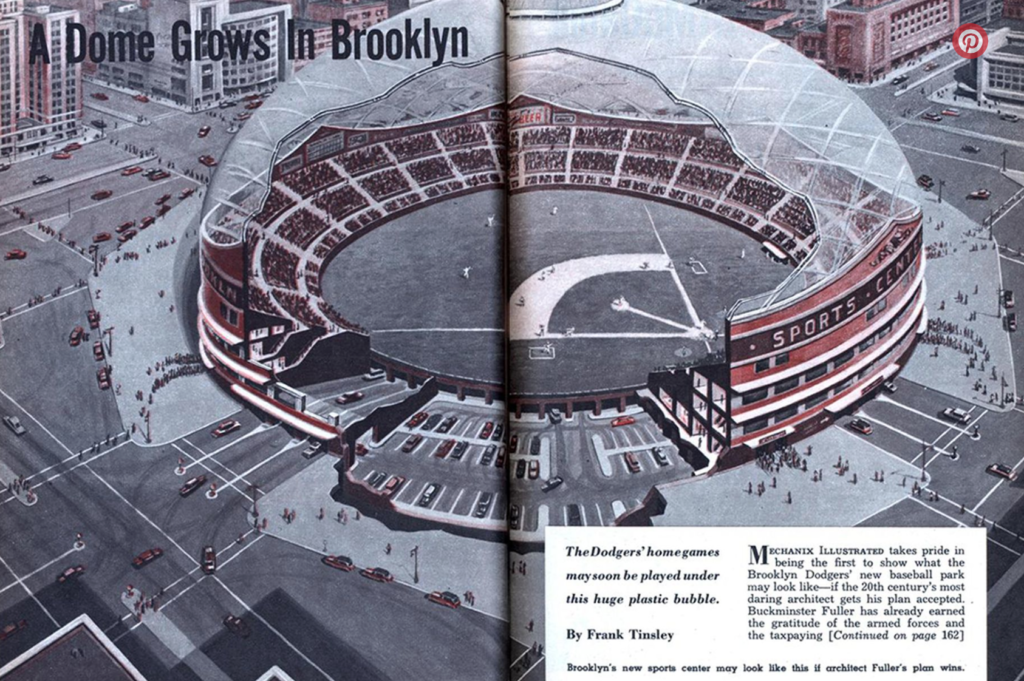How would the city be different if there were an enormous airport runway built on an elevated platform over the West Side Highway? Or if landfill were dumped into New York Harbor and Manhattan were extended five miles so that it ended up nestled between Staten Island’s North Shore and Sunset Park? Or if the Brooklyn Museum were four times as large as it is today, and built to rival the Metropolitan Museum?
These are the questions provoked by Sam Lubell and Greg Goldin’s book, Never Built New York, and are certain to be the theme of Goldin and Lubell’s forthcoming exhibition at the Queens Museum this September. Lubell spoke this week at the Brooklyn Public Library, where he went through some of the most extravagant, otherworldly, and head-scratching architectural projects of the last 200 years that never came to be.
Author Sam Lubell talked about this book this week at the Brooklyn Public Library (Photo by Tyler Woods)
“It tells the story of failure,” Lubell told the audience about the book. “Urban dreams that have been dashed. But that doesn’t have to be depressing. It can be exciting, I think. There’s this whole other alternate history that we didn’t even know exists.”
One piece of that alternate history is that we could have a baseball stadium at Atlantic Terminal, more or less where Barclays Center stands today, and the Dodgers might still be in Brooklyn and the Nets in New Jersey.
The story goes that in 1950, investor and lawyer Walter O’Malley bought a majority share of the Brooklyn Dodgers (originally named the Trolley Dodgers, which makes much more sense in 1920s-era Flatbush, if you’ve ever wondered about the team’s name) from Branch Rickey, he who had signed Jackie Robinson to the team. At that time, the Brooklyn Dodgers played at Ebbets Field, in Flatbush, which couldn’t hold more than about 32,000 fans. O’Malley had a plan to build a new, bigger home for the team, enlisting futuristic architect Buckminster Fuller to build a geodesic dome over a 52,000 person-capacity stadium.
A real-estate mogul proposed an enormous airport that would have stretched 144 blocks along the Hudson River (Image from LIFE via Untapped Cities)
But the plan would’ve required help from the city in the form of the use of eminent domain to open up the space, which was a no-go for New York City power broker Robert Moses, who wanted the team to play in Flushing, Queens, where the city would host the 1964 World’s Fair. Unable to build a stadium the way he wanted, O’Malley dipped, and moved the Dodgers to Los Angeles, where their main rival is the San Francisco Giants, who had followed them out from New York to L.A. in 1958.
L.A. is where Lubell’s idea for the book started. He and coauthor Goldin started doing research for Never Built L.A., in 2011 and published that book in 2013. Lubell was the longtime West Coast editor of The Architect’s Newspaper and more recently has been a staff reporter at Wired.
The Bridge asked Lubell what he thought the most consequential of all the projects in the book might be, for good or ill.
“I think the Lower Manhattan Expressway could’ve been the most impactful,” Lubell said. The Lower Manhattan Expressway was a Robert Moses idea that would have connected Interstate 78, which ends at the Holland Tunnel, to the Brooklyn-Queens Expressway (I-278) by paving a ten-lane highway between the tunnel and the Williamsburg Bridge, over Canal and Delancey streets. It was blocked by public opinion led by urban activist Jane Jacobs in several incarnations in the 1950s and ’60s. “That was almost a done deal. So many cities in America were destroyed because highways were plowed right through them and Manhattan was an exception. It allowed the Manhattan to maintain some of the cohesive downtown that it has. [Otherwise] you wouldn’t have Soho and Little Italy and the exceptional vitality that New York is so lucky to have.”
The Never Built New York exhibition will appear at the Queens Museum Sept. 17 of this year through Feb. 18, 2018. Lubell explained that the exhibit will run through several areas of the museum and that he is working with engineering students from Columbia University to add internally lit never-built structures to the enormous Panorama of the City of New York that currently takes up a larger part of the Queens Museum.
